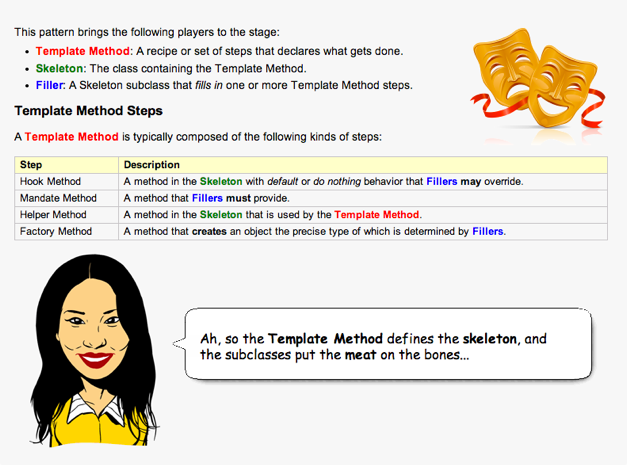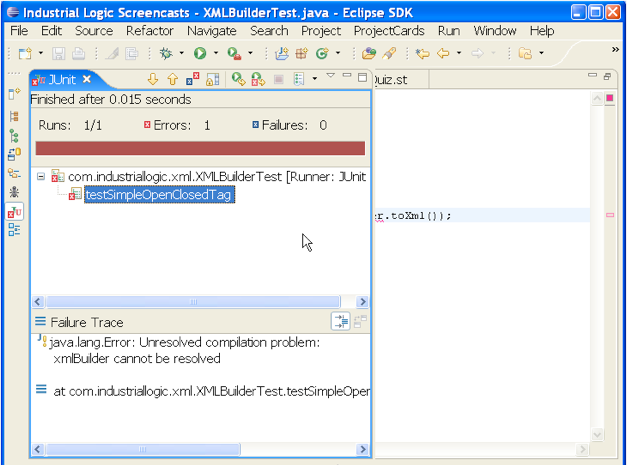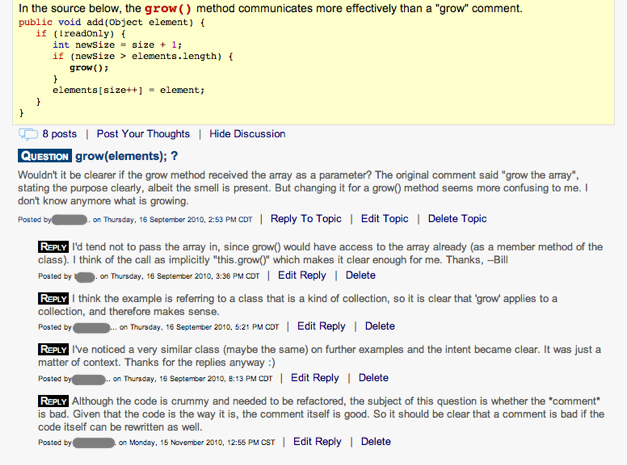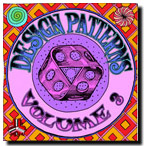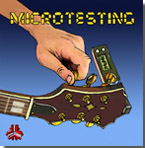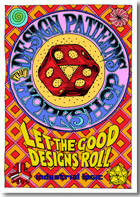Our second volume of Design Patterns focuses on important variations on a classic object-oriented theme: how to
best delegate or forward to cooperating objects, rather than using brute-force inheritance, to get things done.
We explore a common theme in object-oriented design: favoring delegation over inheritance. The album draws from
the Gang-of-Four's Structural and Behavioral patterns and uses them as a starting point.
Highlights

Instant Critiques: Take a refactoring exercise and get instant feedback from our automated band of experts.
Learn more...

Delegation Patterns: Learn a collection of patterns that produce better designs by favoring delegation over inheritance.
Learn more...

Expert Videos: Learn tools & techniques by watching short videos from industry experts.
Learn more...

Integrated Forums: Ask questions, get expert replies and read fascinating discussions.
Learn more...
Includes
- 4-6 hours of content
- 122 pages of content
- 4 Exercises
- 10 Quizzes
- 8 Patterns
- 12 Videos
- Platform-independent code
- Support for Visual Studio
- Support for Eclipse CDT
- Uses Google Test
Contents
| Inside Volume Two ← Click to Preview | 3 |
| The Duh Test | 4 |
| What's in a Name? | 5 |
| Composite | 7 |
| Essence of the Composite Pattern ← Click to Preview | 8 |
| The One/Many Distinction | 9 |
| Refactoring A One/Many Distinction | 10 |
| Composite Players | 11 |
| JUnit: A Classic Composite | 12 |
| XML: A Natural Composite | 13 |
| Know Your Composites | 14 |
| Builder | 16 |
| Why Do We Love Builders? | 17 |
| Complicated, Repetitive and Verbose Composite Construction | 18 |
TagNode: What Needs Improvement?
|
19 |
Which TagBuilder Is Better?
|
20 |
Understanding TagBuilder
|
21 |
| Building Different Products Using Identical Construction Steps | 22 |
| Builder: The Players | 23 |
| Decoupling Construction Logic With A Builder | 24 |
| Builder Quiz | 25 |
| Interpreter | 27 |
| Interpreter: The Essence | 28 |
| The Interpreter Pattern is Not About Parsing | 29 |
| Interpreter: The Players | 30 |
| Introduction ← Click to Preview | 32 |
| Search Expressions | 33 |
| Example Expression | 34 |
| Your Challenge | 35 |
| Problem Code | 36 |
| Critiquing Your Performance | 37 |
| Download and Setup Instructions | 38 |
| Upload Your Exercise | 39 |
| A Graph of Your Refactoring & Testing Activity | 40 |
| Your Critique Results | 41 |
| Your Customized Feedback | 42 |
| Solution | 43 |
| Lambda Solution | 44 |
| Expression Interpreter Problem | 46 |
| How to Construct Expressions | 47 |
| Test First | 48 |
| Extra Credit | 49 |
| Things to Test | 50 |
| Starter Code | 51 |
| Download and Setup Instructions | 52 |
| Expression Interpreter Solution | 53 |
| Pretty Printer Solution | 54 |
| Chain of Responsibility | 56 |
| Essence of the Chain of Responsibility | 57 |
| Tough Ticket | 58 |
| Mike to the Rescue | 59 |
| Meet Mike the Scalper ← Click to Preview | 60 |
| Mike's Supply Chain | 61 |
| The Buck Stops Here | 62 |
| The Players | 63 |
| What Could Go Wrong | 64 |
| Null Anchor Example | 65 |
| Null Object | 67 |
| Too Many Null Checks! | 68 |
| Null Object To The Rescue! | 69 |
| When Is A Null Object Unnecessary? | 70 |
| Null Object Players ← Click to Preview | 71 |
| Much Ado About Nothing | 72 |
| Bridge | 74 |
| Abstract Windowing Toolkit Example of Bridge | 75 |
| MFC Example of Bridge ← Click to Preview | 76 |
| Adapter | 78 |
| Adapter: The Essence | 79 |
| Adapter: The Players | 80 |
| Adapter Example | 81 |
| Two-Way Adapters | 82 |
| Adapter: The Quiz | 83 |
| In Need Of An Adapter ← Click to Preview | 85 |
| Choosing A Preferred Interface | 86 |
| Problem Source Code | 87 |
| Refactoring Guidance | 88 |
| Critiquing Your Performance | 89 |
| Download, Build & Test Instructions | 90 |
| Upload Your Exercise | 91 |
| A Graph of Your Refactoring & Testing Activity | 92 |
| Your Critique Results | 93 |
| Your Customized Feedback | 94 |
| Solution Video Step 1: Extract Interface ← Click to Preview | 95 |
| Solution Video Step 2: Extract Class | 96 |
| Solution Video Step 3: Move Method | 97 |
| Solution Video Step 4: Implement Interface | 98 |
| Solution Video Step 5: Pull Up Fields & Methods | 99 |
| Solution | 100 |
| Decorator | 102 |
| Bloated Objects | 103 |
| Avoiding Bloat | 104 |
| Decorator: The Players | 105 |
| How JUnit Avoided Featuritis | 106 |
| Patterns and Players Quiz | 107 |
| Proxy | 109 |
| Proxy: A Stand-In for Another Object | 110 |
| Proxy: The Players | 111 |
| Proxies Do Computational Chores | 112 |
| Chaining Proxies | 113 |
| Caching Proxy | 114 |
| Protection Proxy | 115 |
| A Problem to Solve | 117 |
| Problem Source Code | 118 |
| Refactoring Guidance | 119 |
| Download, Build & Test Instructions | 120 |
| Solution Source Code | 121 |
| Alternative Solution Source Code | 122 |
Related Items
Highlights

Instant Critiques: Take a refactoring exercise and get instant feedback from our automated band of experts.
Learn more...

Delegation Patterns: Learn a collection of patterns that produce better designs by favoring delegation over inheritance.
Learn more...

Expert Videos: Learn tools & techniques by watching short videos from industry experts.
Learn more...

Integrated Forums: Ask questions, get expert replies and read fascinating discussions.
Learn more...
Includes
- 4-6 hours of content
- 122 pages of content
- 4 Exercises
- 10 Quizzes
- 8 Patterns
- 12 Videos
- Platform-independent code
- Support for Visual Studio
- Support for Eclipse CDT
- Uses Google Test
Contents
| Inside Volume Two ← Click to Preview | 3 |
| The Duh Test | 4 |
| What's in a Name? | 5 |
| Composite | 7 |
| Essence of the Composite Pattern ← Click to Preview | 8 |
| The One/Many Distinction | 9 |
| Refactoring A One/Many Distinction | 10 |
| Composite Players | 11 |
| JUnit: A Classic Composite | 12 |
| XML: A Natural Composite | 13 |
| Know Your Composites | 14 |
| Builder | 16 |
| Why Do We Love Builders? | 17 |
| Complicated, Repetitive and Verbose Composite Construction | 18 |
TagNode: What Needs Improvement?
|
19 |
Which TagBuilder Is Better?
|
20 |
Understanding TagBuilder
|
21 |
| Building Different Products Using Identical Construction Steps | 22 |
| Builder: The Players | 23 |
| Decoupling Construction Logic With A Builder | 24 |
| Builder Quiz | 25 |
| Interpreter | 27 |
| Interpreter: The Essence | 28 |
| The Interpreter Pattern is Not About Parsing | 29 |
| Interpreter: The Players | 30 |
| Introduction ← Click to Preview | 32 |
| Search Expressions | 33 |
| Example Expression | 34 |
| Your Challenge | 35 |
| Problem Code | 36 |
| Critiquing Your Performance | 37 |
| Download and Setup Instructions | 38 |
| Upload Your Exercise | 39 |
| A Graph of Your Refactoring & Testing Activity | 40 |
| Your Critique Results | 41 |
| Your Customized Feedback | 42 |
| Solution | 43 |
| Lambda Solution | 44 |
| Expression Interpreter Problem | 46 |
| How to Construct Expressions | 47 |
| Test First | 48 |
| Extra Credit | 49 |
| Things to Test | 50 |
| Starter Code | 51 |
| Download and Setup Instructions | 52 |
| Expression Interpreter Solution | 53 |
| Pretty Printer Solution | 54 |
| Chain of Responsibility | 56 |
| Essence of the Chain of Responsibility | 57 |
| Tough Ticket | 58 |
| Mike to the Rescue | 59 |
| Meet Mike the Scalper ← Click to Preview | 60 |
| Mike's Supply Chain | 61 |
| The Buck Stops Here | 62 |
| The Players | 63 |
| What Could Go Wrong | 64 |
| Null Anchor Example | 65 |
| Null Object | 67 |
| Too Many Null Checks! | 68 |
| Null Object To The Rescue! | 69 |
| When Is A Null Object Unnecessary? | 70 |
| Null Object Players ← Click to Preview | 71 |
| Much Ado About Nothing | 72 |
| Bridge | 74 |
| Abstract Windowing Toolkit Example of Bridge | 75 |
| MFC Example of Bridge ← Click to Preview | 76 |
| Adapter | 78 |
| Adapter: The Essence | 79 |
| Adapter: The Players | 80 |
| Adapter Example | 81 |
| Two-Way Adapters | 82 |
| Adapter: The Quiz | 83 |
| In Need Of An Adapter ← Click to Preview | 85 |
| Choosing A Preferred Interface | 86 |
| Problem Source Code | 87 |
| Refactoring Guidance | 88 |
| Critiquing Your Performance | 89 |
| Download, Build & Test Instructions | 90 |
| Upload Your Exercise | 91 |
| A Graph of Your Refactoring & Testing Activity | 92 |
| Your Critique Results | 93 |
| Your Customized Feedback | 94 |
| Solution Video Step 1: Extract Interface ← Click to Preview | 95 |
| Solution Video Step 2: Extract Class | 96 |
| Solution Video Step 3: Move Method | 97 |
| Solution Video Step 4: Implement Interface | 98 |
| Solution Video Step 5: Pull Up Fields & Methods | 99 |
| Solution | 100 |
| Decorator | 102 |
| Bloated Objects | 103 |
| Avoiding Bloat | 104 |
| Decorator: The Players | 105 |
| How JUnit Avoided Featuritis | 106 |
| Patterns and Players Quiz | 107 |
| Proxy | 109 |
| Proxy: A Stand-In for Another Object | 110 |
| Proxy: The Players | 111 |
| Proxies Do Computational Chores | 112 |
| Chaining Proxies | 113 |
| Caching Proxy | 114 |
| Protection Proxy | 115 |
| A Problem to Solve | 117 |
| Problem Source Code | 118 |
| Refactoring Guidance | 119 |
| Download, Build & Test Instructions | 120 |
| Solution Source Code | 121 |
| Alternative Solution Source Code | 122 |


